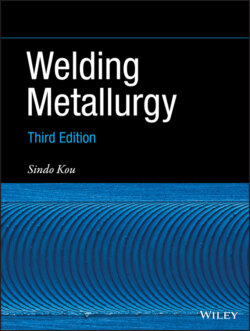Читать книгу Welding Metallurgy - Sindo Kou - Страница 95
3.4 Fluid Flow in Weld Pools 3.4.1 Driving Forces for Fluid Flow
ОглавлениеThe driving forces for fluid flow in the weld pool include the buoyancy force, the Lorentz force, the shear stress induced by the surface tension gradient at the weld pool surface, and the shear stress acting on the pool surface by the arc plasma. The arc pressure is another force acting on the pool surface but its effect on fluid flow is small especially below 200 A [18, 19], which is usually the case for GTAW. The driving forces for fluid flow in the weld pool, shown in Figure 3.15, are explained as follows:
Buoyancy force. The density of the liquid metal (ρ) decreases with increasing temperature (T). Because of the heat source is located above the center of the pool surface, the liquid metal is warmer at point a and cooler at point b. Point b is near the pool boundary, where the temperature is lowest at the melting point. As shown in Figure 3.15a, gravity causes the heavier liquid metal at point b to sink. Consequently, the liquid metal falls along the pool boundary and rises along the pool axis and, as shown in Figure 3.15b.
Lorentz force. GTAW with DC electrode negative is used as an example for the purpose of discussion. The electric current in the workpiece converges toward the tungsten electrode (not shown) and hence near the center of the pool surface. This converging current field, together with the magnetic field it induces, causes a downward and inward Lorentz force, as shown in Figure 3.15c. As such, the liquid metal is pushed downward along the pool axis and rises along the pool boundary, as shown in Figure 3.15d. The area on the pool surface where the electric current goes through is called the anode spot (πb2 where b is the effective radius of the current‐density distribution). The smaller the anode spot is, the more the current field converges from the workpiece (through the weld pool) to the anode spot, and hence the greater the Lorentz force becomes to push the liquid metal downward.
Shear stress induced by surface tension gradient. In the absence of a surface‐active agent, the surface tension (γ) of the liquid metal decreases with increasing temperature (T), namely, ∂γ/∂T < 0. As shown in Figure 3.15e, the warmer liquid metal with a lower surface tension at point a is pulled outward by the cooler liquid metal with a higher surface tension at point b. In other words, an outward shear stress is induced at the pool surface by the surface tension gradient along the pool surface. This causes the liquid metal to flow from the center of the pool surface to the edge and return below the pool surface, as shown in Figure 3.15f. Surface‐tension‐driven convection is also called thermocapillary convection or Marangoni convection.
Shear stress induced by plasma jet. As can be seen in Figure 3.4, the arc plasma can be expected to move outward at high speeds along the pool surface, thus exerting an outward shear stress at the pool surface as illustrated in Figure 3.15g. This shear stress causes the liquid metal to flow from the center of the pool surface to the pool edge and return below the pool surface, as shown in Figure 3.15h. Matsuwana et al. [20] showed that the effect of the shear stress can be significant when the arc is very long, e.g. 8 mm.
Figure 3.15 Driving forces for weld pool convection: (a, b) buoyancy force; (c, d) Lorentz force; (e, f) shear stress caused by surface tension gradient; (g, h) shear stress caused by arc plasma.
These driving forces are included either in the governing equations or as boundary conditions in the computer modeling of fluid flow in the weld pool [21]. Oreper et al. [22] developed the first 2D model for heat transfer and fluid flow in a stationary arc weld pool, but the pool shape was assumed (not calculated). Kou and Sun [23] developed the first 2D axisymmetric (r, z) model of heat transfer and fluid flow that calculated the unknown shape of the stationary arc weld pool. Kou and Wang [24–26] subsequently developed the first 3D (x, y, z) model of heat transfer and fluid flow for moving arc and laser weld pools. Calculating the weld pool shape is essential because the effect of fluid‐flow driving forces on the weld pool shape can be demonstrated clearly. Numerous computer models for fluid flow in the weld pool have been developed by subsequent investigators.
